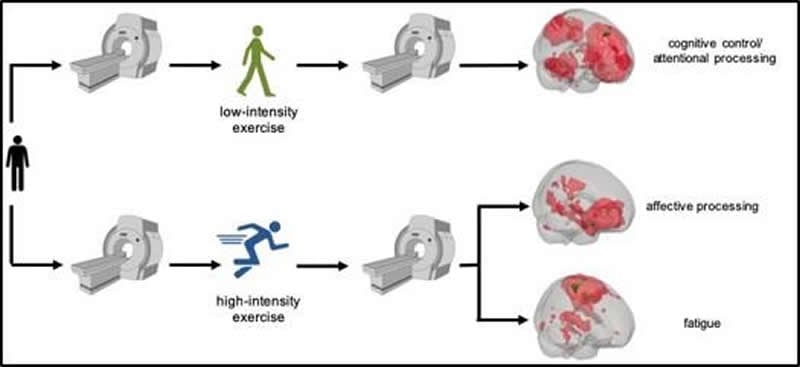Summary: Low-intensity exercise triggers brain networks associated with cognitive control and attention processing, while high-intensity exercise activates networks involved in emotional processing.
Source: IOS Press
A new study shows for the first time that low and high exercise intensities differentially influence brain function. Using resting state functional magnetic resonance imaging (Rs-fMRI), a noninvasive technique that allows for studies on brain connectivity, researchers discovered that low-intensity exercise triggers brain networks involved in cognition control and attention processing, while high-intensity exercise primarily activates networks involved in affective/emotion processing. The results appear in a special issue of Brain Plasticity devoted to Exercise and Cognition.
“We believe that functional neuroimaging will have a major impact for unraveling body-brain interactions,” said lead investigators Angelika Schmitt, MSc, and Henning Boecker, MD, Functional Neuroimaging Group, Department of Radiology, University Hospital Bonn, Bonn, Germany. “These novel methods allow us to ‘look’ directly into the brains of a group of athletes, and, maybe even more importantly, understand the dynamic changes in brain structure and function associated with the transition from a sedentary to a healthy lifestyle.
Twenty-five male athletes underwent individual assessments using an incremental treadmill test. On separate days they performed low- and high-intensity exercise bouts for 30 minutes. Before and after exercising, Rs-fMRI was used to examine functional connectivity of different brain regions that are linked to specific behavioral processes. Participants also completed a questionnaire to measure positive and negative mood before and after the exercise.

The behavioral data showed a significant increase in positive mood after both exercise intensities and no significant change in negative mood. The results of the Rs-fMRI tests showed that low-intensity exercise led to increased functional connectivity in networks associated with cognitive processing and attention. High-intensity exercise, on the other hand, led to increased functional connectivity in networks related to affective, emotional processes. High-intensity exercise also led to a decreased functional connectivity in networks associated with motor function.
The investigators note that this is the first study to report distinct effects of exercise intensity on specific functional networks within the brain at rest. Future research in this area will help provide neurobiological evidence about what type of exercise intensity is best suited for certain neurological or behavioral modulations and may pave the way for supportive clinical applications in patients or for enhancing brain functional plasticity.
Source:
IOS Press
Media Contacts:
Diana Murray – IOS Press
Image Source:
The image is credited to Department of Radiology, University Hospital Bonn, Bonn, Germany.
Original Research: Open access
“Modulation of Distinct Intrinsic Resting State Brain Networks by Acute Exercise Bouts of Differing Intensity”. Angelika Schmitt et al.
Brain Plasticity doi:10.3233/BPL-190081.
Abstract
Modulation of Distinct Intrinsic Resting State Brain Networks by Acute Exercise Bouts of Differing Intensity
Acute exercise bouts alter resting state functional connectivity (rs-FC) within cognitive, sensorimotor, and affective networks, but it remains unknown how these effects are influenced by exercise intensity.
Twenty-five male athletes underwent individual fitness assessments using an incremental treadmill test. On separate days, they performed ‘low’ (35% below lactate threshold) and ‘high’ (20% above lactate threshold) intensity exercise bouts of 30 min. Rs-fMRI and Positive and Negative Affect Scale (PANAS) were acquired before and after each exercise bout. Networks of interest were extracted from twenty-two participants (3 dropouts). Pre-to-post changes and between conditions effects were evaluated using FSL’s randomise by applying repeated measures ANOVA. Results were reported at p < 0.05, corrected for multiple comparisons using threshold free cluster enhancement.
PANAS revealed a significant increase in positive mood after both exercise conditions. Significant effects were observed between conditions in the right affective and reward network (ARN), the right fronto parietal network (FPN) and the sensorimotor network (SMN). Pre-to-post comparisons after ‘low’ exercise intensity revealed a significant increase in rs-FC in the left and right FPN, while after ‘high’-intensity exercise rs-FC decreased in the SMN and the dorsal attention network (DAN) and increased in the left ARN.
Supporting recent findings, this study is the first to report distinct rs-FC alterations driven by exercise intensity: (i) Increased rs-FC in FPN may indicate beneficial functional plasticity for cognitive/attentional processing, (ii) increased rs-FC in ARN may be linked to endogenous opioid-mediated internal affective states. Finally, (iii) decreased rs-FC in the SMN may signify persistent motor fatigue. The distinct effects on rs-FC fit with theories of transient persistent network alterations after acute exercise bouts that are mediated by different exercise intensities and impact differentially on cognitive/attentional or affective responses.







